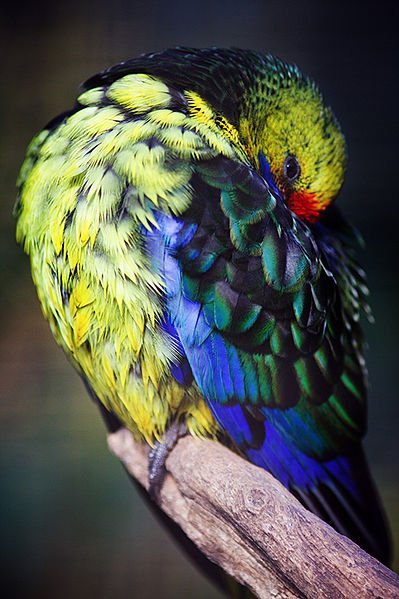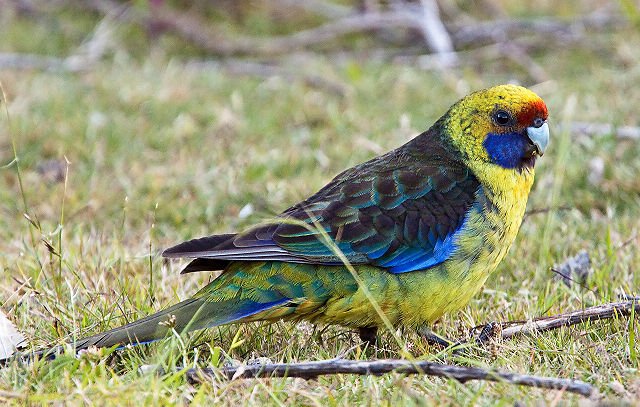Deciding on what pet is ideal for you depends on individual circumstances. Aside from their aesthetic value and comfort, you’ll have to ask yourself – what kind of care does this animal need? How long will it live? What diet should it follow to live a long and healthy life?
If you’re thinking about getting a pet parrot, you’ve probably already come across the different varieties of Rosella parrots. Rosellas are some of the most popular parrot species originating from Australia.
The Green Rosella, otherwise known as the Tasmanian Rosella (named after their natural habitat stretching from Tasmania to the Bass Strait islands) stands out from the rest of the Rosella family.
Green Rosella Color and size
Rosellas are usually very small and feature a mixture of black and colorful large feathers on their wings. Green Rosella wings are very subtle in comparison. Their body is mostly a combination of a variety of deep green shades, sometimes infused with a couple of yellow splatters (which is why they sometimes also call them Yellow-Bellied Rosellas), although they do have the signature bright blue feathers on the cheeks and a red band above their beak.

They are also the longest members of their family, growing around 37cm in length. And, just like the rest of their Rosella family, they also make a very loud statement that they are ready for the Tasmanian wildlife experience – they are quirky, feisty, and intimidating, yet at the same time – they are very intelligent, adaptive, and entertaining.
The more you get to know them, the more you’ll fall in love with them. If the Green Rosella becomes your chosen feathery friend, then keep on reading the rest of this article to find out more about your future pet’s diet and lifespan.
The diet of a Green Rosella
As it naturally lives in dense woodlands, the Green Rosella is predominantly herbivorous, although it will occasionally munch on the odd insect and larvae here and there, such as jumping plant lice living on leaf galls.
Diet in wild
It’s preferred food is whatever grows on trees, shrubs, and sometimes even in the grass on the ground. This includes flowers and nectar, leaves, seeds, nuts, and fresh fruit.
Although Green Rosellas are quite noisy when hanging out in groups on tree branches, their feeding time means serious business. They mostly eat off of shrubs or on the ground, feasting on fallen buds, seeds and fruits rather than picking at trees. When doing so, they quietly pick up their chosen meal with their feet, and remove the edible parts of it with their beak with great focus and attention (they don’t like being disturbed when eating).
Seeds
Green Rosellas like to pick at seeds from trees growing in their natural habitat; this includes buttercups, myrtle beech, Australian blackwood, silver wattle, cranberry heath, and fern seeds. Of course, just like Eastern Rosellas and other Rosella species, a way for Green Rosellas to treat themselves is to reach for some good old Eucalyptus tree seeds.
Flowers
Green Rosellas also like to feast on native trees’ and shrubs’ flowers and flower buds, presumably because the nectar in the flowers is a delicacy for them. These include the flowers of the native plum, hakea, sassafras, shining tea-tree, as well as (of course) flowers of the many varieties of Eucalyptus trees.

Fruits
Hawthorn berries are one of Green Rosella’s favorite desserts. This is due to the large vitamin content, as well as edible seeds in the berries. Hawthorn berries also grow in large amounts on shrubs and tend to fall to the ground easily, so they’re very accessible for our feathery friends.
Green Rosella Diet in captivity
Is there a way to completely mimic the natural feeding experience for Green Rosellas at home? Unless you’re keeping your parrot in a large Tasmanian outside enclosure or have Hawthorn and Eucalyptus growing around your home, probably not. Having said that, this does not mean that your pet Green Rosella needs to have a bland diet consisting completely of pet shop food, either. There are countless of different food items that are safe and healthy for your parrot to consume that are also available all around the globe. You don’t need to feed your Rosella Eucalyptus seeds and Hawthorne berries in order to make it happy, instead – opt for the following:
A seed cocktail
The basic diet of your Green Rosella should always consist of seed. Seeds are high in antioxidants and other nutrients essential for your parrot’s well-being, whilst treats are recommended – but not essential. You don’t have to buy Australian goods off of third-party websites; a good recommendation for a replacement is to get a high-quality Budgie seed mix and Canary seed mix.
It is also recommended that you add other seeds to the mix, such as safflower or sunflower seeds. You can add millets and hulled oats to this blend, as well. Nuts are not to be avoided, but should only be added in smaller amounts, as they are not nutritionally as beneficial for birds as seeds, fruits and vegetables are.
Some Green Rosellas could be picky eaters and will like to munch on seeds exclusively. To add more variety into their diet and make sure that they still eat their dose of fresh greens, you can also give them sprouted or germinated seeds.
Keep in mind that seeds are also very high in calories, and Green Rosellas are known for overindulging in served goods (referencing the previous section – they feed mostly off of what falls on the ground). This could mean that your Rosella gets used to getting more food served on their plate and subsequently ask for more, as well. Monitor your bird’s health closely, and slow down on the sunflower seeds if your friend is getting a little too chunky.
Fruits
Although Green Rosellas mostly munch on Hawthorne berries in their free-roaming life, this is only due to the fact that they pretty much don’t have access to any other fruits. While berries are very healthy for your parrot and the easiest to serve, you can also feed your Green Rosella a large variety of fruit available in the western world, such as apples, oranges, or mango.
The reason as to why many Green Rosellas might refuse to eat fruit could have nothing to do with the taste, but with the size and texture of the fruit. You can try making a puree, or cutting the fruit into smaller bite-sized pieces.
Giving fruit to a parrot with a large appetite is also a good way to keep them at a healthy weight.
Greens and veggies
Leafy greens and vegetables are also a great way for your bird to consume proteins, complex carbohydrates, and also fibre – which will help soothe their digestive tract.
Green Rosellas like to nimble on sweet potatoes, cucumbers, endive and silverbeet. You can also give your bird some eucalyptus leaves and flowers if you have any on hand.
Reminder – if your bird is a picky eater, give them sprouted seeds. Do not skip greens altogether.
What to avoid
Sometimes, your bird could land on the leftovers in your kitchen and pick on them. They might like what they’re eating, but that doesn’t mean that it’s good for them. A couple of good reminders:
The only drinks your parrot should have is freshwater or squeezed homemade and unsweetened fruit juice diluted with water. Do not give them soft drinks, caffeine or alcohol – these can be very toxic.
Do not give your parrot seasoned nuts from snack packets. Too much salt can result in life-threatening sodium poisoning, dehydration and/or kidney damage.
You can occasionally feed your bird egg whites from hard-boiled eggs for more protein, but not fried ones.
Birds do not digest dairy well. If they happen to pick at some cheese here and there most likely won’t cause any harm, but incorporating dairy products on a regular basis might.
Do not let your birds nibble on food items with cyanide-like substances, such as seeds from large-pit fruits. In fact, it’s best to avoid such fruits altogether, as well as pick out any other larger seeds from fruit such as orange seeds or apple seeds before feeding the fruit to your parrot.
Do not give your bird any human sweets, especially chocolate – as chocolate is a stimulant that even we don’t always agree with, either. Candy with artificial sweetener is also off the list, as these can be even more toxic than plain processed sugar.
Green Rosella Lifespan
The average lifespan of a Green Rosella, like most other Rosella birds, is around 15 years, however, Green Rosella Birds in captivity usually live 20 years or more. The reason for this is that birds in captivity can have an even more safe and productive life than when placed in the dangers of the wilderness.
There are many things you can do to help your bird live a long and healthy life, such as;
Giving them a companion
Naturally, Green Rosellas live in pairs, small groups, or even large ones of 50 or more Rosella birds. They like the company. Although you can substitute the company that they’re lacking, it’s best that they have a playmate of their own.
Give them space
No parrot likes to be confined to a small cage, especially not Green Rosellas with a big mouth and big attitude. If you have a garden, making a simple cage-like enclosure could be a good way to give your parrot some sun and exercise. At home, let your parrot out often (preferably – daily). It will help them feed their curiosity and burn extra energy.
Stimulate them
Play with your parrot, sing to your parrot, talk to your parrot. Teach them tricks, show them around, give them toys… The worst thing for a bird in captivity is to be bored.
Monitor their health
You’re the one responsible for whatever happens to your pet bird. Regular vet check-ups are nothing that should be avoided. Better safe than sorry.
Finally, take care of their diet. Your parrot doesn’t really get to pick what they’re eating on their own when in captivity. Don’t be lazy to explore, research and experiment with their food choices. It’s a responsibility you signed up for the day you brought your parrot home. Your efforts will be paid off by prolonging your parrot’s lifespan – giving you more time and happy moments with your new family member.
Featured Photo Credit:Sammy Sam

